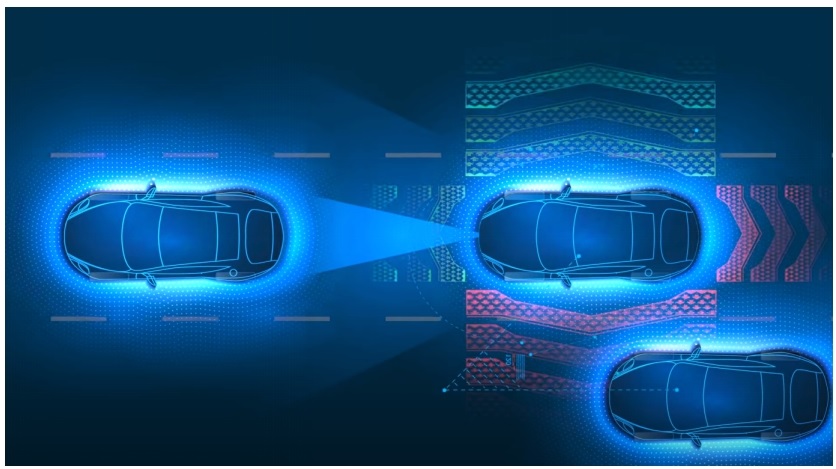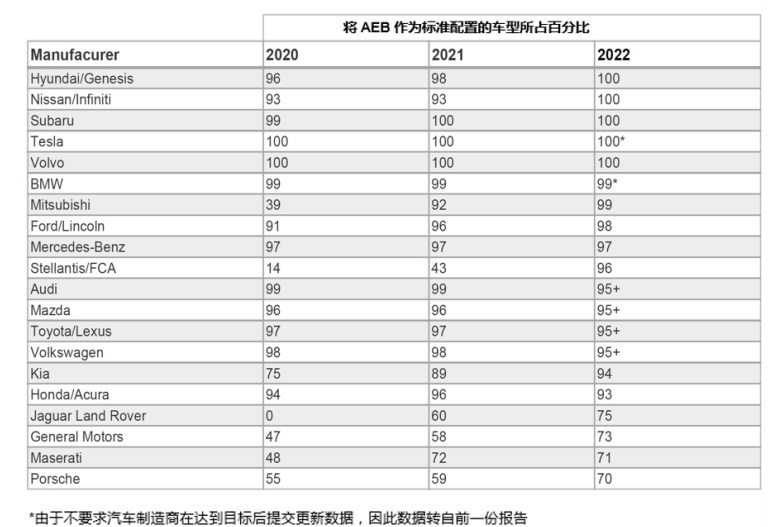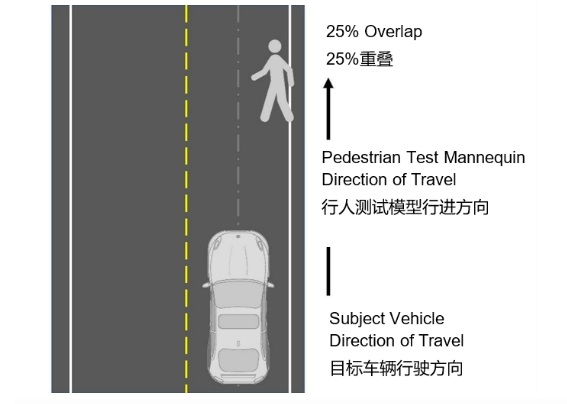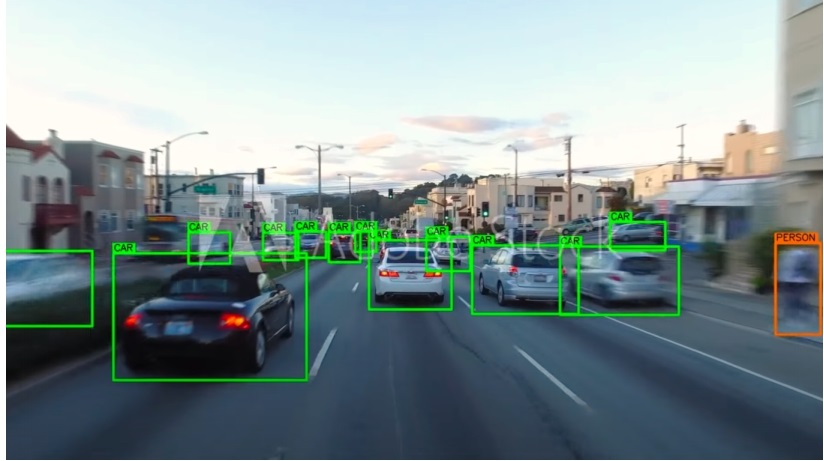Has the Automatic Emergency Braking System (AEB) proposal fallen behind the latest automotive solutions?
Time:2024-04-25
Views:33
Source: ON Automotive Perception By Narayan Purohit
In May 2023, the National Highway Traffic Safety Administration (NHTSA) announced a plan to require all new passenger cars to have automatic Emergency braking (AEB) systems as standard. In simple terms, AEB is the process by which a vehicle automatically activates the brakes to avoid a potential accident. This is a powerful measure that can reduce the speed of a collision or avoid a collision altogether, thereby preventing vehicle damage and casualties.
On the face of it, the plan to impose an AEB system is a good idea. But if NHTSA‘s proposal is to have an impact, it must stay ahead of the industry it hopes to shape. Understanding whether the standard will have a timely impact on the automotive industry, and whether NHTSA‘s plans go far enough, requires not only an understanding of the proposal itself, but also a comprehensive understanding of AEB technology. By exploring the underlying technology, as well as the pace of automakers‘ progress and market trends, it is possible to accurately judge the potential value of NHTSA‘s program.


Figure 1: Schematic diagram of vehicle perception technology
NHTSA‘s planning
In 2016, NHTSA asked 20 automakers representing 99 percent of total U.S. vehicle sales to voluntarily make AEB standard in their passenger car lineup by 2022. Four years later, in 2020, another NHTSA report showed that the industry may have missed the target, with only 10 manufacturers offering AEB as standard. The report theoretically opened the door to mandatory rules, but it was not until May that NHTSA made a proposal. Between the initial requirement and the new proposal, the Insurance Institute for Highway Safety (IIHS) released a follow-up report, shown in Figure 2.


Figure 2: Most car manufacturers have seen significant increases in their equipment volumes between 2020 and 2022
Comparing IIHI‘s data to NHTSA‘s original 2020 report highlights some interesting trends. For starters, 14 out of 20 automakers will equip at least 95 percent of their vehicles with AEB in 2022, up from just 10 two years ago. If we look at the following six special cases, this rapid development process is further highlighted. In 2022, Kia‘s AEB equipment rate was 94%, and Acura‘s AEB equipment rate was 93%, but Acura‘s AEB equipment rate was higher than that before the parts shortage in 2021. For the other four manufacturers, the rate of equipment increased from 38% in 2020 to an average of 72%. In 2023, all manufacturers say AEB deployments will increase again, with General Motors (GM) saying 98% of its 2023 models will be equipped with the technology. This rapid year-to-year growth, and the timing of the NHTSA proposal, raises some interesting questions. The main concern for many is whether this proposal will have a real impact if all manufacturers already have AEB in their entire lineup before the standard is implemented. But understanding why the proposal was introduced adds some weight to its value.
First, it is important to look carefully at the specifics of the proposal. In the event of a collision between vehicles, if the driver fails to react in time, the AEB system is required to apply active braking when the speed reaches 50 miles per hour. If the driver brakes but does not reach the required maximum braking force, the AEB system needs to completely avoid a collision with another car at 62 miles per hour. The proposed vehicle-to-vehicle AEB scenario includes a vehicle approaching a stationary front car, a slow moving front car, and a slowing down front car.
For accidents between vehicles and pedestrians, all vehicles must take action when the speed reaches 40 miles per hour. The proposed vehicle-to-pedestrian AEB scenario includes a vehicle approaching a pedestrian crossing the road (from the left or right), a pedestrian stationary in the path of the vehicle, and a pedestrian walking along the path of the vehicle. The technology also needs to work at night, when NHTSA says more than 70 percent of pedestrian fatalities in the United States occur.
If the proposal is approved by the end of August 2023, it will become mandatory from September 2026 (i.e. model year 2027). If the approval comes later, the mandatory deployment will be delayed by one year (i.e. the 2028 model year).
Given the importance of AEBs in light of statistics such as overnight deaths and the fact that they save 360 lives and at least 24,000 injuries annually in the United States, it‘s obvious why NHTSA is targeting this technology. But given the level of sensors that most vehicles are already equipped with, is mandatory action necessary? Are the proposed regulations really sufficient to meet demand?
AEB specifications: A comparison between the United States and Europe
Given the rapid adoption of the technology, especially in the last three years, it‘s not hard to understand that setting a target date of September 2026 (model year 2027) for mandatory implementation might be too late to make any difference. However, if we compare the situation in the United States with that in Europe, we only get a stronger sense that NHTSA is falling behind The Times.
As of 2019, the implementation of the AEB, a recognized vehicle safety rating method in Europe, is required to obtain a five-star rating for the European New Car Crash Test (Euro NCAP). While this can be seen as progress, the European Commission has gone a step further by mandating that all new cars sold from 2022 must have a vehicle-to-vehicle AEB system. It will also mandate the installation of vehicle-to-pedestrian systems from 2024.
In addition, there are significant differences in scope between the NHTSA proposal and the Euro NCAP regulations. While both standards cover similar vehicle-to-vehicle and vehicle-to-pedestrian AEB scenarios (including adult/child pedestrians and night-time conditions), Euro NCAP also covers several vehicle-to-bicycle and vehicle-to-motorcycle AEB scenarios, taking into account a wider range of vulnerable road users (VRUs).
In addition, unlike the NHTSA proposal, Euro NCAP also covers AEB scenarios that include (left or right) turning vehicles as well as reversing to pedestrians.
Learn about AEB
If we understand how the AEB system works, it will help us properly evaluate potential regulations. As one of the main technologies in Advanced Driver Assistance Systems (ADAS), AEB is a powerful vehicle safety measure that can significantly reduce safety incidents, especially in the case of front-to-rear vehicle collisions and vehicular pedestrian collisions. A typical AEB system combines image sensors, LiDAR, and millimeter-wave RADAR to sense objects that could cause a potential collision. The vehicle analyzes the images in real time and alerts the driver to hit the brakes if a collision is imminent. If the driver fails to apply the brakes in sufficient time, the vehicle will take the initiative to brake.
For image sensors, the AEB system needs to translate into parameter requirements such as Angle of view (FOV), resolution, frame rate and low light level performance, which will directly affect the detectability of objects and the delay of object detection.
As shown in Figure 2, the share of sales of vehicles equipped with AEB capabilities has increased significantly, but this is not the only significant change. In recent years, the underlying technology of vehicles has developed considerably. Processing systems are more powerful, communication systems are faster, data rates are higher, and sensors are becoming more accurate, especially in low-light conditions. Together, these factors are driving AEB systems to become smarter and more reliable, enabling them to take life-saving actions in a wider range of situations.
With more than 15 years of experience in ADAS imaging, On has been at the heart of this technological revolution. As the world‘s leading producer of image sensors for ADAS systems, including AEB, onsemi delivers 70% of the image sensors in all vehicles on the road today.
Comparison of ON‘s Hyperlux with the NHTSA proposal
The new Hyperlux family of image sensors builds on ON‘s deep automotive expertise and is designed to help vehicle manufacturers (Oems) further improve vehicle safety in all conditions, reducing accidents and saving lives. If we compare the latest Hyperlux product line with the NHTSA proposal, we see that the regulation should go deeper, or at least could be implemented sooner.
Let‘s consider the case with the highest speed (and therefore the greatest braking distance) in the vehicle-to-pedestrian scenario: a car is approaching a pedestrian walking along the path of the vehicle. Speeds can reach 40 miles per hour, while pedestrians walk at 3.1 miles per hour.
For this vehicle-to-pedestrian scenario, taking into account typical urban road conditions, the stopping (braking) distance ahead of a vehicle with an ADAS field of view Angle of 120° and a speed of 40 MPH, the response (reaction) time of 0.5 to 1 second, and at least 8 pixels per pedestrian are required to be correctly identified. It is possible to derive a minimum (horizontal) resolution that requires approximately 2480 pixels (using knowledge of high school mathematical geometry).
The Hyperlux AR0823AT sensor (3840 x 2160 pixels) meets the horizontal resolution required for NHTSA‘s most stringent vehicle-to-pedestrian scenarios with a margin of more than 50%, effectively providing up to 12 pixels per pedestrian for robust AEB recognition algorithm operation.


Figure 3. Example of a test scenario for a pedestrian vehicle braking system - basic Settings for pedestrians moving along a path
The new NHTSA recommendation includes an element that was missing from the 2016 recommendation, requiring accurate detection of pedestrians in low-light conditions and at night. For On, this has been a priority and arguably the signature feature of the Hyperlux sensor family, which features a 2.1 μm pixel size and industry-leading 150 dB high dynamic range imaging (HDR). Accurate imaging in luminance scenes from 0.05 lux to 2 million lux.
Let‘s compare the performance of the Hyperlux sensor family in low-light conditions to the NHTSA proposal, again considering the most stringent vehicle-to-pedestrian scenario (e.g., a pedestrian walking along the path of an oncoming vehicle), but this time at night. The proposal mentions an ambient light level of 0.2 lux (moonlight conditions) as well as vehicle low/high beam lighting, but does not specify the illuminance level for vehicle lighting (unlike Euro NCAP).
A 2019 study by the American Automobile Association (AAA) of headlight performance in the United States and Europe showed that the average low light lighting level in pedestrian locations is about 9 lux. Assuming a worst-case pedestrian with 10% reflectivity (wearing dark clothing) and a typical car lens (F-1.4), the illuminance level at the sensor is 0.11 lux.
At a typical integration time of 33ms (night conditions), the Hyperlux sensor family achieves a signal-to-noise ratio (SNR) of 5 at an illuminance level of 0.03 lux (four times lower than the NHTSA‘s prescribed illuminance) and 10 at an illuminance level of 0.10 lux!
When driving out of the tunnel on a sunny day, Hyperlux‘s HDR performance enables the vehicle to instantly see nearby vehicles and any potential hazards beyond the end of the tunnel. In the past, many solutions had insufficient dynamic range to successfully capture both near and far regions of the image, resulting in potential risks that were not visible in the car processor. In the scene shown in Figure 3, the HDR performance of the Hyperlux sensor family is able to accurately track objects in the center, edges and far away of the image, such as cars, traffic lights and pedestrians, even when light levels drop.


Figure 4: Hyperlux sensors accurately track multiple hazards in a variety of challenging visual conditions
The accuracy, integrated safety and compliance with Class B Automotive Safety Integrity (ASIL) safety standards provided by Hyperlux sensors go far beyond what is required for basic AEB applications. Its high precision, high speed and advanced features are already available for ADAS L2 systems and beyond, helping manufacturers transition to autonomous driving.
NHTSA and the future of Vehicle Safety
With NHTSA‘s proposal, we have to ask whether it goes far enough and whether the planned timeline is too long. While any standard aimed at improving vehicle safety should be welcomed in theory, it must be ahead of the industry if it is to have an impact. Judging from the progress made in Europe, NHTSA‘s plans are at least two years behind (for measures between vehicles and pedestrians), and in some cases as much as four years behind (between vehicles). Comparing this standard with the latest perception products once again highlights the gap between the two. Sensors like Hyperlux are already capable of meeting proposed AEB requirements, including performance in low-light environments, while also supporting other technologies such as lane departure systems and fully autonomous driving. By 2026, vehicles equipped with ADAS systems will likely far exceed NHTSA‘s proposed requirements.
If we look at market trends, the story is similar. Automakers are constantly striving to add features to new models to create more premium and safe vehicles for consumers to use, so AEB is one of the expected features. This factor continues to drive sales of vehicles equipped with ADAS technology, such as AEB. As most manufacturers accelerate the deployment of AEB in 100% of their fleet, many designers are working on even more revolutionary ways to improve vehicle safety. While some elements of the NHTSA proposal are positive, such as testing in low-light environments, it is clear that given the time span, the proposal could or should go further. Automakers and their suppliers are working to leverage innovative technologies to improve vehicle safety, reduce auto accidents, and save lives. It is this combination of leading automakers and their supply chain suppliers, such as On, that is likely to mean that many vehicles will be equipped with more advanced safety features by 2026.
|
Disclaimer: This article is transferred from other platforms and does not represent the views and positions of this site. If there is any infringement or objection, please contact us to delete it. thank you! |











